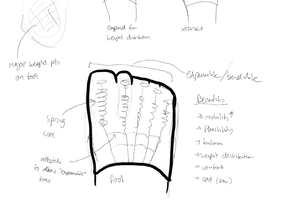Introduction
Many people have dogs, yet the average dog owner does not have a wide enough knowledge base regarding dog training to really know if their dog is well trained. When taking a dog for a walk it is hard to know if the dog is being obedient because no one really knows what force pulls resonate as disobedience and which ones still lie in the range of good behavior. What are the acceptable forces a dog can pull when going for a walk?
The purpose of this experiment was to find a standard for compliance that can be used as a point of comparison while walking a dog. The standard can be used to tell when a dog is being obedient, and how well they are doing in their training. In order to find the acceptable force exerted by the dog, it was necessary to find a way to constantly measure the force of the dog’s pulls during a walk and a way to record this data.
In order to solve this problem, I built a strain gauge leash. The leash consists of a strain gauge (a device for indicating the strain of a material or structure) attached to a microcontroller (a computer present in a single integrated circuit) able to measure and record the force of a dog’s pulls. One side of the strain gauge is attached to a wooden block, while the other side is attached to the leash. The strain gauge is attached to the leash in a way in which when the dog pulls, the leash will pull down on that side of the strain gauge at the same angle each time. The magnitude of the bends in the metal of the strain gauge are sent back to the microcontroller which records and stores the data during the walk. The microcontroller takes and records the tension readings from the strain gauge every 181 milliseconds (5.5 times a second).
The leash allows a way in which to record and analyze the data regarding the force exerted by the dog in order to find what obedience looks like. In order to attach a number or graph to obedience multiple trials with different dog walkers are necessary.
There are numerous applications of the strain gauge leash that can be used by dog trainers, families, obedience classes, etc. The leash can be used by a multitude of people that are looking to train their dog or to see where their dog is at training wise. For instance, it could be used when training service dogs or police dogs because these dogs have to be the epitome of obedience since lives depend on their abilities to follow directions and listen. Another application of the leash is within a family to set the expectations of how a dog should behave with each person. The technology can be used to show how a dog acts differently with different people, or different family members. Additionally, the strain gauge leash can act as a teacher by showing the person walking the dog that they are either doing it correctly or need improvement; it allows the person to see what a good walk looks like on a graph and allows them to track their progress towards that goal.
Right now, the level of obedience is measured by the trainer and is subjective to human bias and opinion. It would be very beneficial to have a more standard way of telling if a dog is obedient on a leash. In addition, those that own dogs and are not experienced dog trainers have no idea what obedience really looks like, so they may be thinking they have a dog that is good, when in reality that is not true. In fact, many people allow their dogs to walk in front of them while walking, basically, allowing their dogs to walk them by pulling them along; when, on a good walk there should be very little force exerted between the dog and the dog walker.
Method
Participants
Three participants participated in this experiment by walking the dog, Daisy, with the strain gauge leash. Daisy is a four year old golden retriever mix with moderate training. Participant 1, Michael, is Daisy’s primary trainer who has had a lot of experience training dogs. Participant 2, me, has some experience walking Daisy and training her, but only on occasion....
Read more »
 John Costik
John Costik
 Zack Freedman
Zack Freedman

 Amanda Brief
Amanda Brief